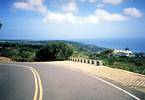|
HOME
>SOUTHERN TAIWAN
>TAINAN&CHIAYI>
ARTICLES >
FYI
SOUTH Magazine,
July 2003. VOL.3 ISSUE 7
Cover Story:
| Kenting:
A true all-things-to-all-people resort
By
Steven Crook |
 |
Kenting
offers a great deal more than sandy beaches and sparkling ocean.
Energetic visitors can happily spend days here without ever getting
their feet wet.
Kenting
National Park--which now covers 20,000 hectares of land, and almost
as much sea--has 15 species of wild mammals (though you're more
likely to see buffalo than macaques), 59 kinds of reptiles and amphibians,
216 species of butterflies, and more than 300 different birds.
 |
October
is a good time for bird watching: During that season, thousands
of migrating Gray-faced Buzzard Eagles and Chinese Sparrow
Hawks pass through Kenting each day.
Offshore,
reefs of soft and stony coral attract scuba divers. Sixty
percent of the world's coral species can be found around Kenting;
these reefs nurture 1,500 kinds of fish. For those visitors
who want to enjoy all this submarine color, diving outfitters
abound. |
HUMAN
HISTORY
The
Hengchuen Peninsula has more than a dozen prehistoric sites, some
of which were inhabited by humans 4,000 years ago. More recent cultural
attractions include the 120-year-old lighthouse at Eluanbi, Hengchuen's
South Gate, and the tiny aboriginal communities that dot the area.
Popular
with tourists since the 1970s, Kenting Road--the resort's main strip--now
hosts well over a hundred businesses run by locals, outsiders, and
foreigners. On weekend evenings it resembles a night market, with
food vendors, souvenir hawkers, and even tattoo artists plying their
trades.
Dawan
Road, quieter and closer to the beach, is home to two of Kenting's
most popular eateries--Warung Didi and the Cactus Cafe.
Unless
you're here for the gastronomy or the nightlife, you shouldn't restrict
yourself to "urban Kenting" and the nearby beaches.
UTMOST
CONVENIENCE
Scooters
can be hired at almost any time of day or night. I arrived
just after 5 am, and had the paperwork completed within 10
minutes.
Provincial
Highway No. 26--the main road through Checheng and Hengchuen--varies
between busy and congested. But the roads that criss-cross
the eastern half of the peninsula make for dream riding: Smooth
tarmac, extremely light traffic, and pleasing scenery at every
turn. |
 |
Some
of the places I saw in the hour after dawn, like the crumbling cliffs
near Lungpan, looked very different when I returned mid-afternoon.
At
one point further up the coast, I had to stop because torpid cows
blocked the road. When the Japanese took over Taiwan, they found
much of the peninsula unsuitable for growing crops, so they turned
it into pastureland.
Later,
a man with a two-meter-plus tuna fish strapped to the back of his
motorcycle overtook me at great speed.
 |
The
Jialeshui Scenic Area, open daily between 8 am and 5 pm, is
the principal attraction in the southeastern quarter of the
peninsula. Admission costs NT$80 for adults, NT$50 for children.
The
coastal walkway through this Scenic Area is very pleasant,
but it can get crowded. As with other parts of Kenting (indeed,
tourist spots throughout Taiwan), avoid weekends and holidays
if at all possible, |
SAND
DUNES AND PALM TREES
Because
Taiwan is a well-watered, fecund island, the shifting sand dunes
at Gangtz are especially intriguing. It's no surprise that at least
two companies offer Jeep tours of the "desert." A circuit
costs NT$300 or so per person, and takes 25-30 minutes.
Aboriginal
villages such as Mudan are good places to break your journey. These
settlements are tidy and attractive, but far from wealthy; spend
some tourist dollars if you can.
I
enjoyed my foray through the less-visited, thinly populated eastern
half of the peninsula so much that it seemed a pity to turn around
and head into the uplands visible from the tourist beaches.
These
hills are largely uplifted coral reefs. It is strange, hundreds
of meters above sea level, to find house-sized chunks of brownish
coral. It's also a vivid illustration of the power and time-scale
of geological processes.
Kenting
Forest Park is a formal but worthwhile introduction to the
area's plants and trees. Exploring the nearby roads--many
are dead-ends, others are rock-strewn farm trails, a few are
alarmingly steep--can be equally rewarding. The surrounding
open pastureland, and the cattle grates on the road, make
for several this-cannot-be-Taiwan moments.
Mountain
biking is certainly an option hereabouts, and rock climbers
will find plenty to occupy them. In fact, when you begin to
count pastimes like stargazing (the unpolluted air and relative
lack of human inhabitants make for ideal conditions), the
list of non-water activities is almost endless. |
 |
There
are hot springs elsewhere on the peninsula if the sea is too cold
for you (unlikely in this season), not to mention the superb National
Museum of Marine Biology and Aquarium.
In
and around Kenting, you can be sure: You'll run out of time before
you run out of things to do.
GETTING
THERE
Unless
you're driving your own vehicle, the only way to get to Kenting
is by bus. At least four companies run frequent services between
Kaohsiung Railway Station and Kenting Road; many buses also stop
at Kaohsiung International Airport. If you're traveling from Tainan
or Chiayi, and would prefer to avoid Kaohsiung's crowds, take a
train to Fangliao (halfway between Pingtung and Kenting), then walk
two minutes to the bus stop directly across the road from the train
station. |